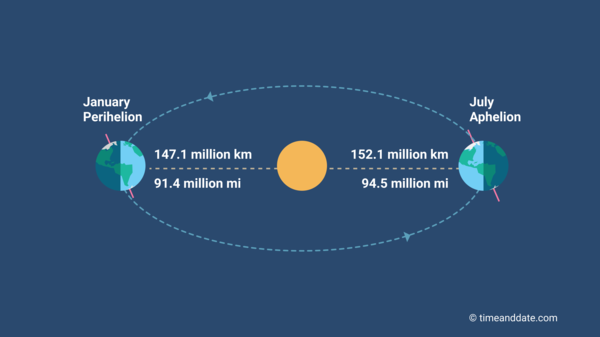Perihelion and Aphelion
The Earth is closest to the Sun, at its perihelion, about two weeks after the December solstice and farthest from the Sun, or at its aphelion, about two weeks after the June solstice.


Earth is farthest from the Sun when it is summer in the Northern Hemisphere.
©timeanddate.com
Earth-Sun distance shaves 15 minutes off summer in 2025
Changing Elliptical Orbit
The Earth orbits the Sun in an elliptical path, which means that there is one point on the path closest to the Sun and one point that is farthest away from the Sun.
Orbit Changes Shape
This path's shape varies due to the gravitational influences of other planetary objects, particularly the Moon. Approximately every 100,000 years, the Earth's orbital path changes from being nearly circular to elliptical. The difference of the Earth’s orbital shape from a perfect circle is known as its eccentricity. An eccentricity value of 0 is a circular orbit, while values between 0 and 1 describe an elliptical orbit.
Aphelion in Maastricht, Netherlands is on
donderdag 3 juli 2025 21:54 CEST (Change city)
Distance from the Sun's center to Earth's center will be 152.087.738 km (94.502.939 mi)
| Year | Perihelion | Distance | Aphelion | Distance |
|---|---|---|---|---|
| 2025 | 4 januari 2025 14:28 | 147.103.686 km | 3 juli 2025 21:54 | 152.087.738 km |
| 2026 | 3 januari 2026 18:15 | 147.099.894 km | 6 juli 2026 19:30 | 152.087.775 km |
| 2027 | 3 januari 2027 03:38 | 147.104.593 km | 5 juli 2027 07:05 | 152.100.481 km |
| 2028 | 5 januari 2028 13:26 | 147.100.687 km | 4 juli 2028 00:18 | 152.093.129 km |
| 2029 | 2 januari 2029 19:13 | 147.098.350 km | 6 juli 2029 07:11 | 152.098.057 km |
| * All aphelion/perihelion times are in local Maastricht time. | ||||
Earth's Perihelion and Aphelion
The Earth is closest to the Sun, or at the perihelion, about two weeks after the December solstice, when it is winter in the Northern Hemisphere. Conversely, the Earth is farthest away from the Sun, at the aphelion point, two weeks after the June solstice, when the Northern Hemisphere is enjoying warm summer months.
Astronomical terms & definitions
Is the Timing a Coincidence?
Due to variations in the eccentricity of the Earth's orbit, the dates when the Earth reaches its perihelion or aphelion are not fixed. In 1246, the December Solstice was on the same day as the Earth reached its perihelion. Since then, the perihelion and aphelion dates have drifted by a day every 58 years. In the short-term, the dates can vary up to two days from one year to another.
Mathematicians and astronomers estimate that in 6430, over 4000 years from now, the perihelion will coincide with the March equinox.
Perigee and Apogee
The Moon's path around the Earth is also elliptical. The point in the Moon's orbit that is closest to the Earth is called the perigee and the point farthest from the Earth is known as the apogee. The terms are also sometimes used interchangeably with the Earth's perihelion and aphelion.
Did You Know...
...that the words perihelion and aphelion come from ancient Greek, where peri means close, apo means far, and helios means the Sun? They are used in astronomy to refer to the closest and farthest points of the orbits of any object revolving around the Sun. Together, they are called apsides—the points of least or greatest distance of a celestial object in orbit around another astronomical body.